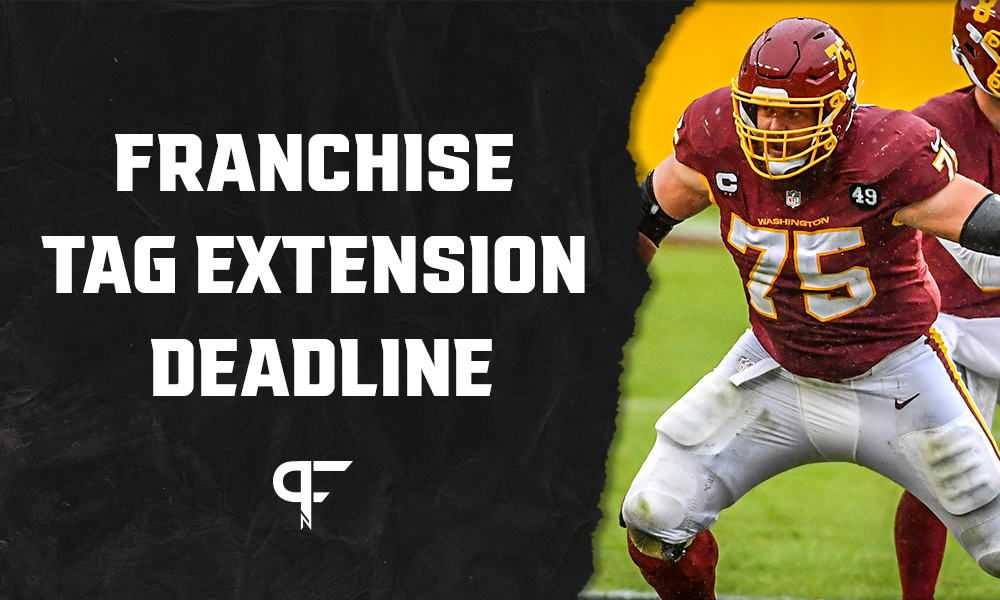The NFL deadline to sign contract extensions for the seven players still on the franchise tag is 4 p.m. Thursday.
If a deal is not reached, each will play the 2021 season on the one-year tender and then head to free agency again next spring.
Will any franchise-tagged players get a new deal before the deadline?
Of the 10 players tagged this cycle, three have signed extensions: Cowboys quarterback Dak Prescott, Giants defensive tackle Leonard Williams, and Broncos safety Justin Simmons.
The seven players who have yet to land a long-term deal (and their PFN ranking in respective top position groups across the NFL):
- New Orleans Saints safety Marcus Williams ($10.6 million guaranteed 2021 salary, seventh on PFN’s top 25 safeties in the NFL).
- Carolina Panthers offensive tackle Taylor Moton ($13.8 million, 12th).
- Jacksonville Jaguars offensive tackle Cam Robinson ($13.8 million, unranked).
- Tampa Bay Buccaneers wide receiver Chris Godwin ($16 million, 13th).
- Chicago Bears wide receiver Allen Robinson ($17.9 million, sixth).
- Washington Football Team offensive guard Brandon Scherff ($18 million, fourth).
- New York Jets safety Marcus Maye ($10.6 million, sixth).
For some of these seven, it remains a bit of a mystery what, if any, progress has been made on an extension since February.
There is some clarity, however, with others. NFL Network reported this week that Robinson, Maye, and Scherff are not close to signing long-term deals.
Will any modifications to the franchise tag occur in the near future?
It’s fashionable for players and their representatives to crush the franchise tag and how it works. They argue, correctly, that it cuts down on stars’ leverage and limits their long-term security.
And for short-horizon, non-premium positions like running back and safety, a franchise year could cost them eight figures in lifetime earnings. Injuries happen. So do bad seasons in tagged years.
And yet, the tag probably isn’t going anywhere. The NFLPA membership likely doesn’t want to waste the political capital to fight over it in the next round of CBA negotiations (which are years off anyway).
Just one-half of one percent of the players who will be on Week 1 rosters will be impacted by the tag this year. Plus, there’s this inconvenient truth cutting against the NFLPA’s argument — the tag isn’t all bad for all players.
Franchise Tag Case Study: Cam Robinson
He’s being paid like a top-10 tackle (if you disregard a lot of the funny money handed out by teams in 2021 due to the depressed cap). But you’d be hard-pressed to argue he’s a top-10 tackle. In fact, the Jaguars overpaid by millions to keep him, based on Spotrac’s calculated market value.
Then there’s Scherff, who’s not only the highest-paid guard in the league this year, he’s also been given $33.1 million in guaranteed money the past two seasons. That is more than any guard on a long-term deal has been granted. That’s what happens when you get tagged two years in a row.
What’s more, WFT can’t tag Scherff a third time, so he is guaranteed to reach the open market next March. Assuming he’s healthy, some team will give him a long-term deal with even more millions attached.
One more point — after 2021, Scherff will have already made nearly $67 million in his career. It will move him into third on the all-time lifetime earnings list at his position.
And Scherff has done it without a second contract.
Want more NFL news and analysis?
Be sure to follow us on Twitter (@PFN365) to stay in the loop on all things around the NFL. Also, continue to visit Pro Football Network for NFL news and in-depth analysis concerning the 2021 season and beyond.

